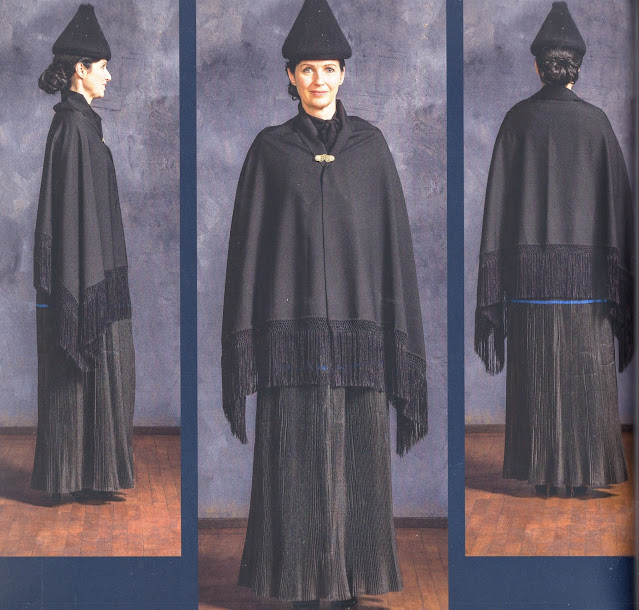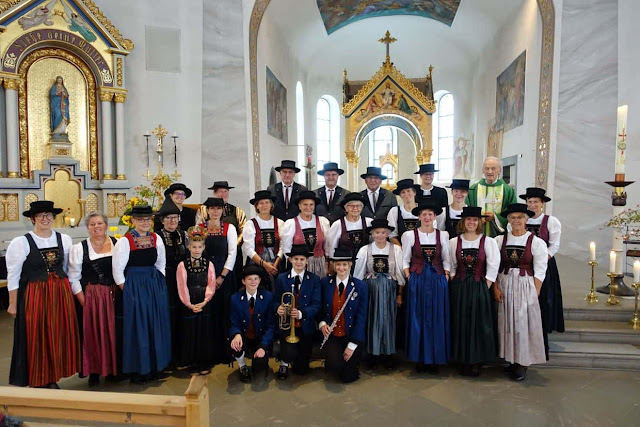Hello all,
Today I will talk about Vorarlberg, the westernmost province of Austria. Although this is the smallest of the Austrian provinces, excepting the city of Vienna, it has an amazing variety of Traditional Attire, both folk and urban. The two images above show some of this variety, the first photo was taken in 1924, and the second in 2022. The costumes in the second image have been modernized, and none of the participants chose to wear the headgear which form part of the outfits.
Vorarlberg is bordered by Tyrolia to the east, Bavarian Swabia to the north, The Swiss Canton of St. Gallen and Liechtenstein to the west, and the Swiss Canton of Graubünden to the south.
Although historically this province has been part of Austria, linguistically, culturally, and in terms of Folk costume, it has much more in common with Switzerland. Unlike in the rest of Austria, the people speak Allemanic dialects. In fact, in 1919, over 80% of the inhabitants voted in a referendum to join Switzerland. However, several of the minority communities of Switzerland were lukewarm to the idea of another German-Speaking, majority Catholic Canton further reducing their own percentage of the population. Also, this would have left Liechtenstein completely surrounded by Switzerland. Because of these and other political issues, the merger never took place.
The tracht of this region fall into three categories, 1, Old tracht with a continuous history, 2, new tracht originating in the Tracht renewal movement which began in the early to mid 20th century, and also invented the dirndl, and 3, Urban 'patrician' tracht.
Following my sources, I will present the Trachten of Vorarlberg according to the 11 regions on the map above. [click on the map to enlarge it].
1. Leiblachtal
2. Bregenzerwald
3. Kleinwalsertal
4. Grosswalsertal
5. Tannberg
6. Klostertal
7. Montafon
8. Brandnertal
9. Laternsertal
10. Walgau
11. Rheintal and Vorderland
Examples of the 'New Tracht'.
These are examples of the simplicity and practicality of 'New Tracht' in general.
They were invented for use by anyone who resides in Vorarlberg.
The Vorarlberg Dirndl
A loden overjacket and the typical straw hat of this region are also shown.
worn with relatively informal dress
Bregenzerwald
Region 2
This region has a well preserved ancient tracht tradition.
The main garment is a jumper called Juppe. It has a very short bodice with a rounded neckline that is bordered by an embroidered band. The body of the juppe is made of a finely pleated linen or woolen blend. It is worn over a blouse or chemise with full shoulders, plus an embroidered plastron and kerchief tucked around the back of the neck. The juppe also has a band of a contrasting color inserted somewhat above the knee.
The juppe comes in four variants: white with red bodice, brown with red bodice, black with red bodice, and most formal, black with black bodice. All of the dark variants are worn with an apron.
The white juppe was the original garment. According to legend, a group of women armed with pitchforks put to flight the Swedish army that attacked the city of Egg during the 30 yrs war, who mistook them for heavenly beings. After that battle, the bloodstained juppe were put away, and married women started wearing dark ones.
Today the white juppe is only worn by girls and very young women. The bodice and plastron are red, the blouse is white, and the kneeband is blue. It is commonly worn with a simple headband, the girl's festive crown schappale, or a white fuzzy cap. It is worn with a belt that has a decorative buckle in back.
The white juppe was replaced by the brown juppe for married women. This was made of a woolen blend, and has a red bodice. This continues to be worn as a winter version of the tracht, known as wilfling, often worn with fur cap.
In the middle of the 18th cent. the brown juppe was replaced by a black linen one, under the influence of Spanish fashion. This is the most common juppe worn today, with either a red or black bodice, the black being considered more festive and formal. The blouse is no longer strictly white, but can be made of various different colors. The kneeband continues to be blue, but in modern times it is often worn with an apron. In this first image we can see how the blouse is made.
Besides the festive crown, which was only worn by unmarried girls or brides, a flat straw hat was worn. See the images above and this one.
The black bodiced version of the juppe often had more elaborate embroidery on the plastron and sometimes gold lace or trim on the bodice.
Besides the straw hat, fur caps, breamokappe, and knitted woolen caps shaped like Hershey's kisses, spitzkappe, were worn, especially in winter. The latter were also known in Tyrol.
Men wore a blue work smock for everyday, and a type of suit with a red vest for more dressy occasions.
This was based on an old painting.
In the north of Bregenzerwald, this relatively low lying district has its own new tracht, which includes characteristics of the nearby Rhine valley trachten, including relatively small versions of the radhaube, 'wheel headdress'.
And that concludes part 1 of my overview of the trachten of Vorarlberg.
I hope that you have found this to be interesting and informative.
Roman K.
email: rkozakand@aol.com
Source Material:
'Die Trachten in Vorarlberg', Ulrike Bitschnau et al, Bregenz 2022
'Alpentrachten Unserer Zeit', Karl Wolf et al, Wien, 1937
'Trachten in Österreich', Rudolf Fochler, Wels, 1980
'Die Goldene Bodensee-Radhaube', Michael Selb, Wien, 2011
'Österreichische Trachtendirndl', Maria Strnad, Wien, 1950
'Tracht in Österreich', Franz C. Lipp et al, Wien, 1984
'Ostmark Fibel', Kuno Brandauer, Munich, 1941






































































.png)







.jpg)
.jpg)

Hello! In searching for the author and primary source of restored embroidery patterns, Google brought me to your blog. I make jewelry with micro-embroidery, would you mind if I use your patterns for my work? http://folkcostume.blogspot.com/2014/09/
ReplyDeletePlease feel free. I collect these images from many sources and provide them as free information for those who are interested.
DeleteThe style is so unique. Thanks for publishing this kind of blog, Keep blogging!
ReplyDeleteExcellent site you’ve got here. I appreciate individuals like you! Take care!!
ReplyDeleteLot of interesting information here. Thanks for sharing. keep it up
ReplyDeleteThanks for a very interesting blog. Waiting for the next blog updates.
ReplyDeleteIts full of information here that I am looking for, Great work you have in here!
ReplyDelete